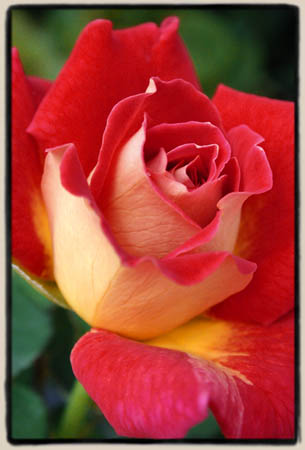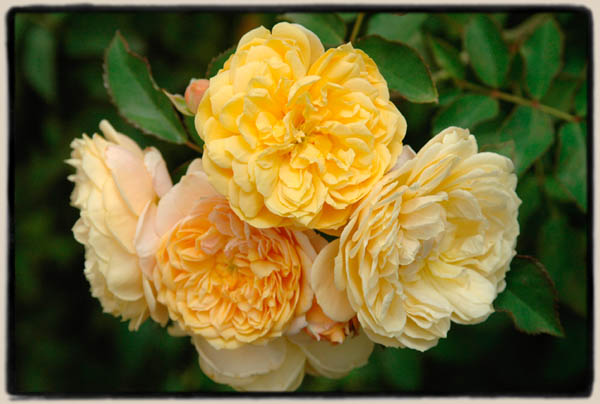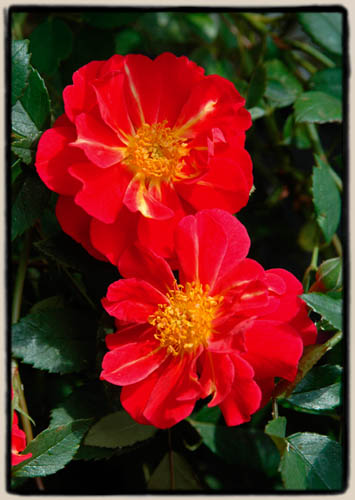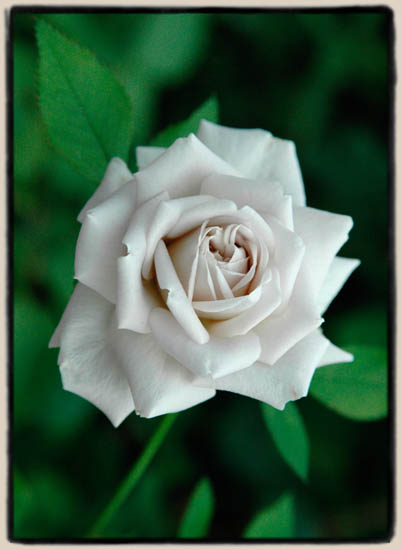 |
|
Albas |
Welcome to the December 2005 edition of my web site! The roses I write about are the Old Garden Roses and select shrub and miniature roses of the 20th century. For tips on rose culture, pruning, propagation and history, see the "Site Resources Guide" box in the navigation panel at left. To return to this page, click on the "thorn icon" in the margin at left. Articles from the previous months are archived and can be viewed by clicking on the listings in the left margin. Oh, and please don't write to me for a catalog or pricelist.....this is an information site only, not a commercial nursery. If you wish to buy roses, see my sponsor, The Uncommon Rose. Discovering How Color Works The following article appeared in the Rose Hybridizers Association Newsletter, Fall 2005. If you have an interest in rose breeding and wish to learn more, check out the RHA web site. The RHA Newsletter is always informative and members are eager to share their ideas and experiences. Peter Harris asked recently if I could contribute a brief article about color breaks in my breeding work. Frankly, I don't think the term “color breaks” has much meaning anymore, since we have seen pretty much every color possibility turn up in rose breeding, with the exception of blue, of course. The closest thing I have seen to a real color break in recent years would be Tom Carruth's 'Midnight Blue', which comes as close to the purple hue of 'Cardinal de Richelieu' as any modern rose ever has. (David Austin made the same comparison with 'The Prince' years ago, which is in my opinion, wishful thinking; they are both purple hues but thats where the similarity ends.)
One similar cross using 'Tuscany Superb' and 'Othello' gave me a seedling with very Gallica-like growth habit and cupped 4" blooms in a medium reddish-pink. The plant itself was appealing for its hardiness and complete resistance to Blackspot, and so I bred it one generation further, combing it with the deep purple-crimson Hybrid Perpetual 'Souvenir du Dr. Jamain'. This step showed considerable sterility and only one seedling was kept. (I don't recall if there were others) This seedling, recorded as simply "tusc-o-jam", is a 5 X 5 foot shrub, somewhat upright, with plentiful Spring bloom and a smattering of bloom a few weeks after that. Blooms are cupped, very double, 3.5" in diameter, mauve-pink and have an exceptionally strong Licorice fragrance. It sets no seed but has fertile pollen, which I have used a few times. It seems to pass on large flower form, doubleness and much richer coloring than it has itself. It also tends to pass on rich fragrance of the Licorice/Myrrh sort. I am currently evaluating two seedlings that resulted from a cross using ('Penny Ante' X 'Tradescant') as the seed parent. ('Penny Ante' is also the parent of a striking bicolor seedling that resulted when I used 'Grey Pearl' as a pollen parent. The seedling looks like a much larger 'Glowing Amber' with a red topside and a golden yellow reverse! (See photo at left.) Both have rich crimson coloring and strong scents, and the blooms are much larger then either parent. I am beginning to see the differences between parents that tend to produce plenty of washed out offspring (often poor replicas of the parent) and parents that harbor the ability to produce seedlings that are very variable and with characteristics that deviate significantly from their parent's appearance. (The classic Phenotype VS Genotype situation). In 2003 I made a cross on 'Joycie' using 'Trier', the early Hybrid Musk. The seeds germinated in March of 2004 and I obtained about 120 seedlings. (Close to 100% germination) My first impression was that I had a group of once-bloomers in that cross, since not a one of them had flowered by late May. They were all vigorous and most had superb mildew resistance, but it wasn't until mid-June that the first flowers started to appear. Soon, dozens were flowering, in shades of warm pinks, peaches, clear yellows, oranges and bright reds. The color range was remarkable and quite unexpected, especially the rich reds. Many of the well-pigmented clones darkened as the blooms aged when they were moved outdoors in Summer 2005; a very China-like quality. Several of these are very Polyantha- Another Miniature that I use for breeding is 'Sequoia Ruby', one of Ralph Moore's climbing miniatures. Although I have seen one of Ralph's plants reach well above my head climbing out of one of his greenhouses, I find the plant doesn't exceed 4 feet tall in my garden. 'Sequoia Ruby' came out of a cross of "1-72-1", sister seedling to 'Rise 'N' Shine' and the old Floribunda 'Floradora'. This plant has some real merits as a breeder, but some real drawbacks as well, in my opinion. It produces copious seed that germinates well, and its offspring are often a remarkable array of colors, but on the downside, it wants to breed plants very similar in habit to itself. I have found it very difficult to obtain anything but lookalike Miniatures, regardless of what pollen parent I use on it. Most interestingly, I have three times obtained Grey-mauve seedlings from various crosses. One of the best is a 12" plant with the most peculiar gunmetal grey blooms, cupped, about 1 inch in diameter. Unfortunately, none of these seedlings has sufficient vigor to merit further evaluation; all are very poor growers. This seems to be a problem with many roses of unusual coloring. (See photo below right ) Occasionally I get a few green seedlings from my work, usually resulting from two seed parents: "Sheri Anne' and 'Golden Angel', in combination with any variety of pollen parents. This year I am watching a new green seedling with 2 inch very double blooms that came from a cross of 'Golden Angel' X "Precious Dream'. It has very glossy leaves and blooms with abandon. Most interesting is a deep red, very thin picotee line around many of the petals edges. I look forward to seeing this odd plant grow up. In 2004 I germinated one seedling that displayed very unusual coloring and great vigor as well. It is listed in my records as 79-03-02, resulting from a cross of [(Little Darling X Yellow Magic) X Grandmother's Hat*] X Brown Velvet. It was one of only a few seedlings that germinated from that cross, and the only one that flowered the first year. It was, in fact, very quick to bloom as a small plant, bearing a 2 inch bloom with about 10 loosely arranged petals in a very odd muddy orange hue, overlaid with smoky purple towards the outer edges. This was a very curious seedling, considering the fact that the seed parent is pale yellow fading quickly to white! My first impression was that it was an oddity, but hardly pretty. I almost tossed out it in August, thinking it had little merit. (A reminder that we should not be hasty in making these decisions!) It grew with fierce vigor, building several 4 foot canes by October, and blooming several times before onset of Winter weather. The following Spring it burst into growth with enthusiasm and its new growth was a deep plum color, as was the new foliage. It hadn't occurred to me until then how attractive the plant was, with its twiggy, bushy habit. The first blooms amazed me; they were that magical hue of red shared by few roses such as 'Smoky', and 'Jocelyn', a deep oxblood/mahogany color resulting from that odd blending of purple over deep orange. The half-open buds were the most remarkable color of all, paling somewhat to a deep rust hue, still overlaid with smoky purple which deepened as the bloom aged. At that point I was grateful that I had kept this seedling. As the Summer of 2005 went on, I watched this rose blooming without pause. It starts forming a new bloom cluster immediately behind the previous one, often before the last one is finished, making it truly constant with bloom. It has clusters of up to 8 or 10 blooms, each averaging 3 inches across, with about 15 or 20 petals each. The shift of color from mahogany buds (with a Chinese red reverse) to deep orange and purple open blooms and a final deepening of the purple to "Smoke Bush" coloring is remarkable. The new wood is always a plum color and is not very thorny, thankfully. So far this has built up to make a somewhat cascading shrub about 5 X 5 feet. As a bonus, its cuttings root very readily. This has been the most remarkable "color break" in my work to date and I plan on using it as a seed parent next year to see if it holds any magic as a breeder. To see photos of 79-03-02, go to the following HelpMeFind page. (The photo below left is 79-03-02) *"Grandmother's Hat” (also known in commerce as “Barbara Worl”) might possibly be the 1894 Hybrid Perpetual 'Mrs. R.G. Sharman-Crawford'.
Original photographs and site content © 2005 Paul Barden, All Rights Reserved. |
|

 For the first few years I worked with roses I crossed deeply pigmented Gallicas with modern roses, like the Austins and some miniatures. While I found that such crosses generally yielded well colored offspring, it seemed that modern rose genes often diluted the color intensity, resulting in plenty of dark pinks, mauves and fuchsia hues. (Gallica X Gallica crosses, however, resulted in a majority of very deeply colored offspring) One particularly misguided cross involved Black Jade X Tuscany Superb, which resulted in some rather bizarre offspring in various shades of deep pink on plants that were mostly unmannerly large shrubs and awkward climbers. Three were kept: a large deep pink shrub with shapely blooms of 25 petals on a rounded 7 X 7 foot shrub, a climber-ish miniature with black-red small blooms, and a very Gallica-like 5 X 5 foot shrub that has blooms very much like 'Constance Spry', complete with a pleasant Myrrh-like fragrance. All of these are Spring bloomers, and all but the latter set seeds. Both of the seed setters have been tried as parents and neither has produced anything of interest. Perhaps I abandoned them too soon and they may have something to offer since I am now pursuing a line of breeding for Miniatures which are significantly more Winter hardy than current hybrids. Miniatures with Zone 4 hardiness would be a grand goal, I think.
For the first few years I worked with roses I crossed deeply pigmented Gallicas with modern roses, like the Austins and some miniatures. While I found that such crosses generally yielded well colored offspring, it seemed that modern rose genes often diluted the color intensity, resulting in plenty of dark pinks, mauves and fuchsia hues. (Gallica X Gallica crosses, however, resulted in a majority of very deeply colored offspring) One particularly misguided cross involved Black Jade X Tuscany Superb, which resulted in some rather bizarre offspring in various shades of deep pink on plants that were mostly unmannerly large shrubs and awkward climbers. Three were kept: a large deep pink shrub with shapely blooms of 25 petals on a rounded 7 X 7 foot shrub, a climber-ish miniature with black-red small blooms, and a very Gallica-like 5 X 5 foot shrub that has blooms very much like 'Constance Spry', complete with a pleasant Myrrh-like fragrance. All of these are Spring bloomers, and all but the latter set seeds. Both of the seed setters have been tried as parents and neither has produced anything of interest. Perhaps I abandoned them too soon and they may have something to offer since I am now pursuing a line of breeding for Miniatures which are significantly more Winter hardy than current hybrids. Miniatures with Zone 4 hardiness would be a grand goal, I think. So what does this have to do with color breaks? This preface is all about my learning experience over the past decade, learning by trial and error what roses produce what kind of results, and which roses have that extra something that creates magic in breeding work. One very useful plant I have used for four years now is 'Joycie', a medium orange Miniature by Ralph Moore. Bred from 1-72-1 X Gold Badge, 'Joycie' is a very compact grower with 1.5 " blooms of about 20 petals; barely double, really. It sets seed very readily and takes pollen from almost anything. One very nice thing about using it from the breeder's perspective is that its seeds are very large and very easily extracted from the hips, making it a pleasure to handle and process. Even more useful, nearly every seed germinates readily. Now, some Miniatures I have worked with produce a lot of lookalike progeny; inferior copies of itself. 'Rise 'n' Shine' is one such plant, although if you grow lots of seeds, you will find an occasional prize. However, I consider plants like 'Joycie' to be much more valuable for their "malleability": an ability to act unpredictably when crossed with other things and to readily take on characteristics of the pollen parent, especially if the other parent is a non-miniature.
So what does this have to do with color breaks? This preface is all about my learning experience over the past decade, learning by trial and error what roses produce what kind of results, and which roses have that extra something that creates magic in breeding work. One very useful plant I have used for four years now is 'Joycie', a medium orange Miniature by Ralph Moore. Bred from 1-72-1 X Gold Badge, 'Joycie' is a very compact grower with 1.5 " blooms of about 20 petals; barely double, really. It sets seed very readily and takes pollen from almost anything. One very nice thing about using it from the breeder's perspective is that its seeds are very large and very easily extracted from the hips, making it a pleasure to handle and process. Even more useful, nearly every seed germinates readily. Now, some Miniatures I have worked with produce a lot of lookalike progeny; inferior copies of itself. 'Rise 'n' Shine' is one such plant, although if you grow lots of seeds, you will find an occasional prize. However, I consider plants like 'Joycie' to be much more valuable for their "malleability": an ability to act unpredictably when crossed with other things and to readily take on characteristics of the pollen parent, especially if the other parent is a non-miniature.  like plants, remaining short and bushy, while others are large shrubs with 5 and 6 foot arching canes that bloom along the upper half of the canes. Three stand out as favorites; a bright red with a yellow eye, 2 inch blooms in clusters on a glossy-leaved plant that builds to 5 feet, so far. (Photo at left) There is a modest fragrance of clove and the red fades to a deep pink with age. Another choice is a remarkably lovely 6 foot arching shrub with clusters of 3 inch blooms in a yellow-peach blend. (Photo above, very double yellow) In cooler weather, they often have a hint of red to the opening blooms. There is also a rich Hybrid Musk scent. Blooms are very double with a button eye. Remarkable is the fact that the bloom size exceeds that of both parents by quite a bit. The third of my selections is a pumpkin-orange cluster-blooming shrub of similar style and size to the second one I described, but with dark reddish-bronze foliage. Blooms are semi-double and deepen with a reddish cast as they age in the sun. This one, however, lacks fragrance.
As I mentioned, there are also some clear Canary yellow clones which show promise, with 2.5 to 3 inch blooms in a very pleasing hue. I have no doubt that at least one of these selections will make it into commerce.
like plants, remaining short and bushy, while others are large shrubs with 5 and 6 foot arching canes that bloom along the upper half of the canes. Three stand out as favorites; a bright red with a yellow eye, 2 inch blooms in clusters on a glossy-leaved plant that builds to 5 feet, so far. (Photo at left) There is a modest fragrance of clove and the red fades to a deep pink with age. Another choice is a remarkably lovely 6 foot arching shrub with clusters of 3 inch blooms in a yellow-peach blend. (Photo above, very double yellow) In cooler weather, they often have a hint of red to the opening blooms. There is also a rich Hybrid Musk scent. Blooms are very double with a button eye. Remarkable is the fact that the bloom size exceeds that of both parents by quite a bit. The third of my selections is a pumpkin-orange cluster-blooming shrub of similar style and size to the second one I described, but with dark reddish-bronze foliage. Blooms are semi-double and deepen with a reddish cast as they age in the sun. This one, however, lacks fragrance.
As I mentioned, there are also some clear Canary yellow clones which show promise, with 2.5 to 3 inch blooms in a very pleasing hue. I have no doubt that at least one of these selections will make it into commerce.  I have also been watching a very interesting Floribunda type seedling that came from a 2002 cross of 'Sequoia Ruby' X 'Scarlet Moss'. It is a tall growing plant, probably more useful as a cut flower than a landscape-worthy shrub, with 3 to 4 inch “Angel Face mauve” blooms that have a lovely soft tan-brown center. I would probably be more certain about its future as a commercial introduction, except that so far it has proved difficult to propagate from cuttings. Perhaps I will simply bud it instead, since I think it is a really lovely rose.
I have also been watching a very interesting Floribunda type seedling that came from a 2002 cross of 'Sequoia Ruby' X 'Scarlet Moss'. It is a tall growing plant, probably more useful as a cut flower than a landscape-worthy shrub, with 3 to 4 inch “Angel Face mauve” blooms that have a lovely soft tan-brown center. I would probably be more certain about its future as a commercial introduction, except that so far it has proved difficult to propagate from cuttings. Perhaps I will simply bud it instead, since I think it is a really lovely rose.  Finding interesting or unique color in rose breeding is challenging, to say the least. As many more experienced breeders than me will tell you, the vast majority of your work will result in lots of white and dull pink seedlings, and very little makes it past first cull based on bloom color alone. I can only suggest to hybridizers searching for interesting colors in their work, that they use parents that are as different from each other as possible, especially where color is concerned, and keep a watchful eye on your seedlings for potentially interesting colors. Many seedlings take at least a full year to begin displaying their potential, so don't be too hasty in throwing curious seedlings out either.
Finding interesting or unique color in rose breeding is challenging, to say the least. As many more experienced breeders than me will tell you, the vast majority of your work will result in lots of white and dull pink seedlings, and very little makes it past first cull based on bloom color alone. I can only suggest to hybridizers searching for interesting colors in their work, that they use parents that are as different from each other as possible, especially where color is concerned, and keep a watchful eye on your seedlings for potentially interesting colors. Many seedlings take at least a full year to begin displaying their potential, so don't be too hasty in throwing curious seedlings out either.